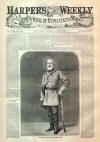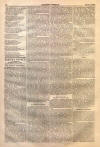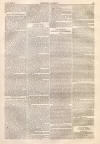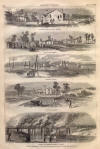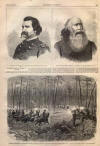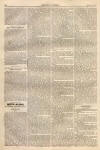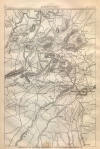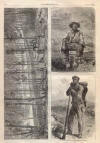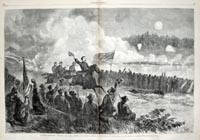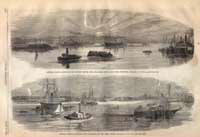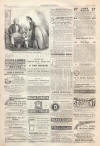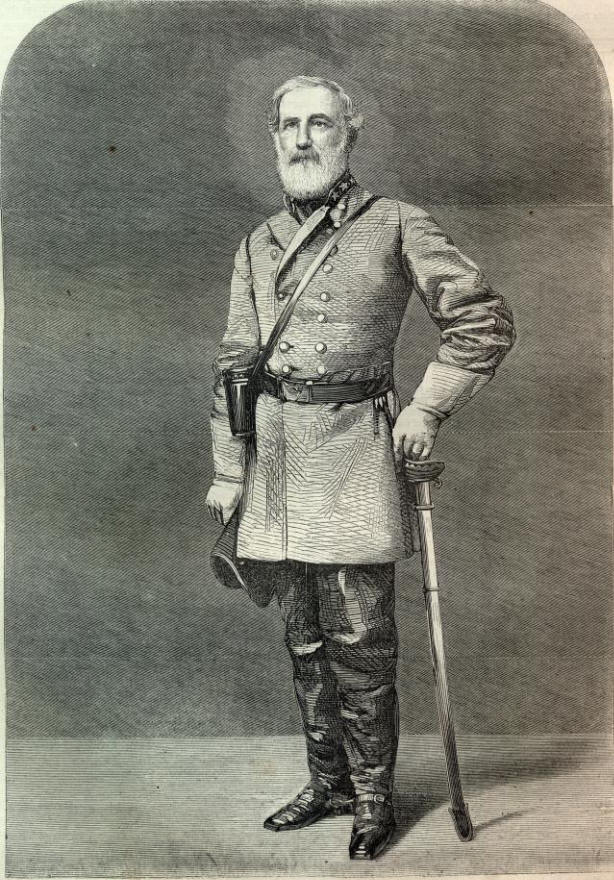|
This Site:
Civil War
Civil War Overview
Civil War 1861
Civil War 1862
Civil War 1863
Civil War 1864
Civil War 1865
Civil War Battles
Confederate Generals
Union Generals
Confederate History
Robert E. Lee
Civil War Medicine
Lincoln Assassination
Slavery
Site Search
Civil War Links
Civil War Art
Mexican War
Republic of Texas
Indians
Winslow Homer
Thomas Nast
Mathew Brady
Western Art
Civil War Gifts
Robert E. Lee Portrait
|
NEW YORK, SATURDAY, JULY 2, 1864.
$1,00 FOR FOUR MONTHS.
$3,00 PER YEAR IN ADVANCE.
Entered according to Act
of Congress, in the Year
1864, by Harper & Brothers, in the
Clerk's Office of the District Court for
the Southern District of New York.
GEN. ROBERT EDMUND LEE.
GENERAL
ROBERT E. LEE,
Commander-in-Chief
of the Rebel Armies, whose portrait we give on
this page, is unquestionably a consummate master
of the art of war. That superiority, indeed, was
acquired at the expense and under the patronage of
the Government he is now endeavoring to destroy;
but this does not alter the fact. His career, prior
to his desertion of the flag of the country, may be
briefly stated. Born in 1808, he was regularly educated
at West Point. In the Mexican campaign
he served with the Engineer Corps, and was twice
promoted for gallantry. At Chapultepec he was
severely wounded. In 1852, while holding the rank
of Major, he
was appointed Superintendent of the
Military Academy ; but three years
afterward he was sent to Europe with
McCLELLAN, then a Captain, to study the
proceedings of the French and English armies in the siege of Sebastopol. About
that time he was advanced to the rank of Lieutenant-Colonel of the Second
Regiment of Cavalry, and this was his position when the traitorously forsook his
country and entered the rebel service.
General LEE, now in his
fifty-sixth year, is six feet in height, erect, well-formed, and of imposing
appearance ; has clear black eyes, dark-gray hair, and a heavy gray beard. He is
plain in dress, wearing a black felt hat with a narrow strip of gold around it,
and a plain Brigadier's
coat with three stars on the collar. He is said to be popular with his
army, but the conviction is growing that in
General GRANT he has met his match ;
and the confidence now entertained in him is not, probably, as great as
formerly. In the present campaign he has displayed great tenacity and skill in
the management of his army; but in all the elements of strategy
GRANT has proved more than his equal.
The photograph from which our engraving is made is one taken by Messrs.
MINNIS & COWELL, of
Richmond, which bears the stamp of its legal registration in 1863,
"in the District Court of the
Confederate States for the Eastern District
of Virginia."
GEN. SHERMAN'S
CAMPAIGN.
WE continue our illustrations
of
General SHERMAN'S
campaign in Georgia, which is
only second in importance to
that of General GRANT in
Virginia.—On pages 424 and
425 we present a stirring
picture of the REBEL ASSAULT ON
GENERAL LOGAN'S
POSITION in the battle
at Dallas, May 28. The first
attack of the enemy was made
upon General HARROW'S Division,
and a portion of the incomplete earth-works on the
extreme front were carried by
the assailants and a part of a
battery captured. This success,
however, was but momentary ; WALCOTT's
Brigade immediately charged,
driving back the enemy and
recapturing the battery. The
assault then became general.
General
LOGAN, seeing the importance
of the crisis, dashed along the
lines with words of cheer and
encouragement, and in a few
minutes his troops were swarming
over the works and rushing resistlessly down upon the now
retiring foe. The rebel assault
was made by CHEATHAM'S,
BATES'S,
and WALKER'S
divisions
of HARDEE'S
Corps. The men
said they were told
the
assault was to be made upon a negro brigade and a
few hundred-days'
men. Their loss in the assault was 3000 men. Our picture shows General MORGAN
L. SMITH'S
Division on the extreme left, General
OSTERHAUS's
Division next on the right, and General HARROW's
on the extreme right.
On page 421 we give a sketch, showing
GENERAL
HOOKER'S
ESCORT CHARGING
THROUGH THE
WOODS, and opening the battle near Dallas, May 25. In
approaching Dallas this corps marched in three columns, General HOOKER
being with the centre column, under
the command of General GEARY.
Just as the head of the column reached Pumpkin Vine Creek a few shots
were fired by a small force of rebels. The escort under Captain DUNCAN
dashed
across the bridge, which had been fired but not consumed, and a sharp skirmish
ensued, the rebel force (of cavalry)
being driven hack until the ammunition of the body-guard was exhausted. Then a
charge was made, led by Captain DUNCAN of the
escort and Colonel FESSENDEN of
General HOOKER's
staff. Just at this time the head of General GEARY'S
column came up and was soon heavily engaged. Thus opened the battle of Dallas.
Before night of the same day the commands of Generals WILLIAMS,
BUTTERFIELD,
HOWARD, and PALMER were all in position.
Another sketch, illustrative of the same battle, is given on page 428. It shows
General WILLIAMS'S Division of HOOKER'S Corps driving the rebels
through the woods. Colonel
ROBINSON'S
Brigade is
on the left, General RUGER'S in
the centre, and General
KNIPE'S on the right. On page
420 we give five sketches,
showing the scene of several important events in
SHERMAN'S
campaign. One sketch shows
the Eighth Missouri Regiment of LOGAN'S
Corps reaching the railroad bridge at sunrise on the
16th of May. The enemy having evacuated Resaca
on the night of the 15th, our advance was made at
dawn by
General
LOGAN'S Corps, and Resaca
very shortly entered by the
Eighth Missouri, the men
dashing through the town toward the bridges. The
railroad bridge was destroyed, together with the old
wooden bridge just fired by the enemy. The rebels
had departed so quickly that they had left a caisson
on the bridge, and four guns in
a small earthwork nearby.—Some of the soldiers went on to
the bridge and threw into the
water the planks already
on fire. Of the towns of
which our artist gives
sketches he writes as follows
:
"Adairsville is a small hamlet on
the Dalton and Atlanta
Railroad. Woodlands, as the
map gives it, is the
residence of
Mr. BAIRDSLEY, an Englishman
who has made some money
in this country, and has since
the commencement of the war
been a purchasing agent for the
"Confederate Government."—A
slight skirmish took place on
the afternoon of 18th directly
in front of the house, in which
the Colonel of the Second Pennsylvania
was killed by the Brigade of
Colonel Wilder. This Colonel
was a very gallant man, and
was only killed because he would not surrender.
Kingston, like the railroad
towns of the South, has few
houses. Since the battle of
Chicamauga it has been used
as a hospital. The inhabitants
having been removed further
south, it is now the last station
on the railroad, and is likely to
be the scene of much activity."
On page 426 we give a topographical Map illustrative of
General SHERMAN'S
campaign since the capture of' Resaca.
After that event the army crossed the Oostanaula River in two columns—one
column, under HOOKER and
SCHOFIELD,
crossing just below Resaca; and the other, under McPHEARSON,
THOMAS, and
BUTTERFIELD,
at New Echota, a little to the left of Resaca. This latter column separated
itself into two after crossing the
river, THOMAS and
BUTTERFIELD
moving on the left, and
McPHERSON
on the right flank ; while in the mean-time HOORER and SCHOFIELD
kept the centre, moving toward Kingston, along the line of the Chattanooga
Railroad. The rebel line of defense,
stretching along the line of the railroad connecting Rome and Atlanta,
north of the Etowah River,
not being able to resist this combination, was broken up. — Kingston and
Cassville thus came into our
possession, though not without some sharp
fighting. As
a matter of course,
Rome was no longer tenable by a rebel force. After resting for a few days and
obtaining fresh supplies the Etowah was crossed, and Dallas—in the rear of which
JOHNSTON was intrenched—was made the objective of the new lines of approach.
Altoona Pass, through which the Western and Atlantic Railroad runs to Atlanta,
was taken by our cavalry; and this success, together
with the victory of
May 28, forced the rebels to
adopt a new line of' defense covering
Marietta, along Lost and Kenesaw
mountains. On the
night of June 18 this line was partly withdrawn,
but still covered
the advance to Marietta.
THE REBEL GENERAL ROBERT EDMUND LEE.
We acquired this leaf for the purpose of digitally
preserving it for your research and enjoyment. If you would like
to acquire the original 140+ year old Harper's Weekly leaf we used to
create this page, it is available for a price of $500. Your
purchase allows us to continue to archive more original material. For
more information, contact
paul@sonofthesouth.net
|
